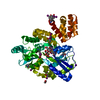+ Open data
Open data
- Basic information
Basic information
| Entry | Database: PDB / ID: 6mks | |||||||||
|---|---|---|---|---|---|---|---|---|---|---|
| Title | Cryo-EM structure of NLRC4-CARD filament | |||||||||
 Components Components | Chimera protein of NLR family CARD domain-containing protein 4 and EGFP | |||||||||
 Keywords Keywords | PROTEIN FIBRIL / NLRC4 / Helical assembly / Inflammasome | |||||||||
| Function / homology |  Function and homology information Function and homology informationIPAF inflammasome complex / The IPAF inflammasome / icosanoid biosynthetic process / canonical inflammasome complex / caspase binding / positive regulation of protein processing / pattern recognition receptor signaling pathway / TP53 Regulates Transcription of Caspase Activators and Caspases / pyroptotic inflammatory response / detection of bacterium ...IPAF inflammasome complex / The IPAF inflammasome / icosanoid biosynthetic process / canonical inflammasome complex / caspase binding / positive regulation of protein processing / pattern recognition receptor signaling pathway / TP53 Regulates Transcription of Caspase Activators and Caspases / pyroptotic inflammatory response / detection of bacterium / endopeptidase activator activity / activation of innate immune response / bioluminescence / positive regulation of interleukin-1 beta production / generation of precursor metabolites and energy / : / protein homooligomerization / positive regulation of inflammatory response / defense response to bacterium / positive regulation of apoptotic process / inflammatory response / innate immune response / intracellular membrane-bounded organelle / apoptotic process / magnesium ion binding / protein homodimerization activity / ATP binding / identical protein binding / plasma membrane / cytosol / cytoplasm Similarity search - Function | |||||||||
| Biological species |  Homo sapiens (human) Homo sapiens (human) Vaccinia virus Vaccinia virus | |||||||||
| Method | ELECTRON MICROSCOPY / helical reconstruction / cryo EM / Resolution: 3.4 Å | |||||||||
 Authors Authors | Zheng, W. / Matyszewski, M. / Sohn, J. / Egelman, E.H. | |||||||||
| Funding support |  United States, 2items United States, 2items
| |||||||||
 Citation Citation |  Journal: J Biol Chem / Year: 2018 Journal: J Biol Chem / Year: 2018Title: Cryo-EM structure of the NLRC4 filament provides insights into how symmetric and asymmetric supramolecular structures drive inflammasome assembly. Authors: Mariusz Matyszewski / Weili Zheng / Jacob Lueck / Brendan Antiochos / Edward H Egelman / Jungsan Sohn /  Abstract: Inflammasomes are supramolecular signaling platforms integral to innate immune defense against invading pathogens. The NOD-like receptor (NLR) family apoptosis inhibitory protein (NAIP)·NLR family ...Inflammasomes are supramolecular signaling platforms integral to innate immune defense against invading pathogens. The NOD-like receptor (NLR) family apoptosis inhibitory protein (NAIP)·NLR family caspase-recruiting domain (CARD) domain-containing 4 (NLRC4) inflammasome recognizes intracellular bacteria and induces the polymerization of the caspase-1 protease, which in turn executes maturation of interleukin-1β (IL-1β) and pyroptosis. Several high-resolution structures of the fully assembled NAIP·NLRC4 complex are available, but these structures do not resolve the architecture of the CARD filament in atomic detail. Here, we present the cryo-EM structure of the filament assembled by the CARD of human NLRC4 (NLRC4) at 3.4 Å resolution. The structure revealed that the helical architecture of the NLRC4 filament is essentially identical to that of the downstream filament assembled by the CARD of caspase-1 (casp1), but deviates from the split washer-like assembly of the NAIP·NLRC4 oligomer. Our results suggest that architectural complementarity is a major driver for the recognition between upstream and downstream CARD assemblies in inflammasomes. Furthermore, a Monte Carlo simulation of the NLRC4 filament assembly rationalized why an (un)decameric NLRC4 oligomer is optimal for assembling the helical base of the NLRC4 filament. Together, our results explain how symmetric and asymmetric supramolecular assemblies enable high-fidelity signaling in inflammasomes. | |||||||||
| History |
|
- Structure visualization
Structure visualization
| Movie |
 Movie viewer Movie viewer |
|---|---|
| Structure viewer | Molecule:  Molmil Molmil Jmol/JSmol Jmol/JSmol |
- Downloads & links
Downloads & links
- Download
Download
| PDBx/mmCIF format |  6mks.cif.gz 6mks.cif.gz | 574.4 KB | Display |  PDBx/mmCIF format PDBx/mmCIF format |
|---|---|---|---|---|
| PDB format |  pdb6mks.ent.gz pdb6mks.ent.gz | 432.1 KB | Display |  PDB format PDB format |
| PDBx/mmJSON format |  6mks.json.gz 6mks.json.gz | Tree view |  PDBx/mmJSON format PDBx/mmJSON format | |
| Others |  Other downloads Other downloads |
-Validation report
| Summary document |  6mks_validation.pdf.gz 6mks_validation.pdf.gz | 1.1 MB | Display |  wwPDB validaton report wwPDB validaton report |
|---|---|---|---|---|
| Full document |  6mks_full_validation.pdf.gz 6mks_full_validation.pdf.gz | 1.1 MB | Display | |
| Data in XML |  6mks_validation.xml.gz 6mks_validation.xml.gz | 49.5 KB | Display | |
| Data in CIF |  6mks_validation.cif.gz 6mks_validation.cif.gz | 79.4 KB | Display | |
| Arichive directory |  https://data.pdbj.org/pub/pdb/validation_reports/mk/6mks https://data.pdbj.org/pub/pdb/validation_reports/mk/6mks ftp://data.pdbj.org/pub/pdb/validation_reports/mk/6mks ftp://data.pdbj.org/pub/pdb/validation_reports/mk/6mks | HTTPS FTP |
-Related structure data
| Related structure data |  9137MC M: map data used to model this data C: citing same article ( |
|---|---|
| Similar structure data |
- Links
Links
- Assembly
Assembly
| Deposited unit | 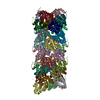
|
|---|---|
| 1 |
|
- Components
Components
| #1: Protein | Mass: 38668.805 Da / Num. of mol.: 31 Source method: isolated from a genetically manipulated source Source: (gene. exp.)  Homo sapiens (human), (gene. exp.) Homo sapiens (human), (gene. exp.)  Vaccinia virus Vaccinia virusGene: NLRC4, CARD12, CLAN, CLAN1, IPAF, UNQ6189/PRO20215, EGFP Plasmid: pET21b / Production host:  |
|---|
-Experimental details
-Experiment
| Experiment | Method: ELECTRON MICROSCOPY |
|---|---|
| EM experiment | Aggregation state: FILAMENT / 3D reconstruction method: helical reconstruction |
- Sample preparation
Sample preparation
| Component | Name: NLRC4-CARD filament / Type: COMPLEX / Entity ID: all / Source: RECOMBINANT |
|---|---|
| Molecular weight | Units: MEGADALTONS / Experimental value: NO |
| Source (natural) | Organism:  Homo sapiens (human) Homo sapiens (human) |
| Source (recombinant) | Organism:  |
| Buffer solution | pH: 7 Details: 20mM HEPES at pH 7.4, 400mM NaCl, 10% glycerol, 1mM EDTA and 1mM DTT |
| Specimen | Embedding applied: NO / Shadowing applied: NO / Staining applied: NO / Vitrification applied: YES |
| Specimen support | Grid material: COPPER |
| Vitrification | Cryogen name: ETHANE / Humidity: 100 % |
- Electron microscopy imaging
Electron microscopy imaging
| Microscopy | Model: FEI TITAN |
|---|---|
| Electron gun | Electron source:  FIELD EMISSION GUN / Accelerating voltage: 300 kV / Illumination mode: FLOOD BEAM FIELD EMISSION GUN / Accelerating voltage: 300 kV / Illumination mode: FLOOD BEAM |
| Electron lens | Mode: BRIGHT FIELD / Cs: 2.7 mm |
| Specimen holder | Cryogen: NITROGEN |
| Image recording | Average exposure time: 12 sec. / Electron dose: 42 e/Å2 / Detector mode: COUNTING / Film or detector model: GATAN K2 SUMMIT (4k x 4k) / Num. of real images: 1690 |
- Processing
Processing
| Software | Name: PHENIX / Version: dev_2919: / Classification: refinement | |||||||||||||||||||||
|---|---|---|---|---|---|---|---|---|---|---|---|---|---|---|---|---|---|---|---|---|---|---|
| EM software |
| |||||||||||||||||||||
| CTF correction | Type: PHASE FLIPPING AND AMPLITUDE CORRECTION | |||||||||||||||||||||
| Helical symmerty | Angular rotation/subunit: 100.6 ° / Axial rise/subunit: 5 Å / Axial symmetry: C1 | |||||||||||||||||||||
| Particle selection | Num. of particles selected: 402078 | |||||||||||||||||||||
| 3D reconstruction | Resolution: 3.4 Å / Resolution method: FSC 0.143 CUT-OFF / Num. of particles: 299537 / Algorithm: BACK PROJECTION / Symmetry type: HELICAL | |||||||||||||||||||||
| Atomic model building | Protocol: FLEXIBLE FIT | |||||||||||||||||||||
| Atomic model building | PDB-ID: 4IKM Accession code: 4IKM / Source name: PDB / Type: experimental model |
 Movie
Movie Controller
Controller



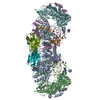

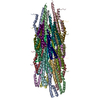

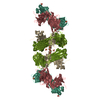

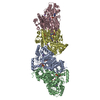

 PDBj
PDBj










